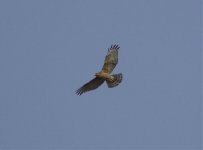I'm considering buying a spotting scope to get better close up views of birds. I now have a DSLR with a range of lenses. Get a broad range of quality in results (maybe 10% are real keepers) but would like to see the more distant aves clearer.
Has anyone gone from DSLR to digiscoping or vice versa? I always like to capture the moments as I'm not good at remembering details to identify birds after the fact. Does serious digiscoping preclude regular viewing?
At this point, if I do get a scope I'd probably keep the DSLR handy anyway but if I can lighten the load to go with scope and a small digital, that might be preferable.
I guess the real question is for those who have done both, which results in the best and most consistent results?
Cheers,
Matt
Has anyone gone from DSLR to digiscoping or vice versa? I always like to capture the moments as I'm not good at remembering details to identify birds after the fact. Does serious digiscoping preclude regular viewing?
At this point, if I do get a scope I'd probably keep the DSLR handy anyway but if I can lighten the load to go with scope and a small digital, that might be preferable.
I guess the real question is for those who have done both, which results in the best and most consistent results?
Cheers,
Matt




